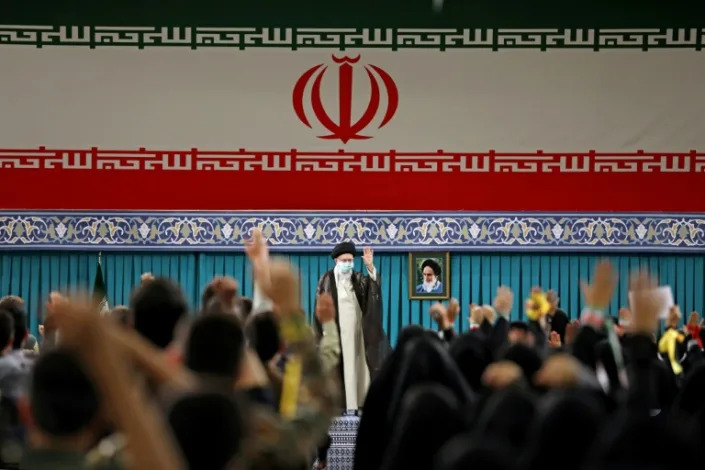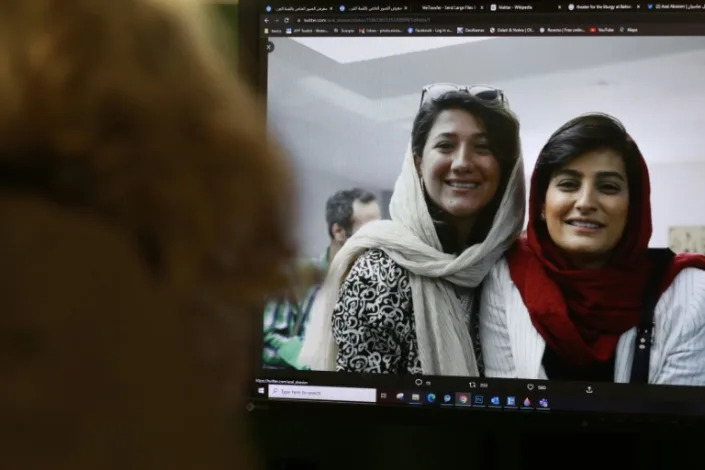NEWS WIRES
Thu, 3 November 2022

© AFP
Iranian protesters clashed with police in a town near the capital on Thursday, reportedly killing or wounding a number of members of the security forces, who at one point dropped stun grenades on the demonstrators from helicopters.
It was the latest in a wave of demonstrations that have convulsed Iran for more than six weeks and mark one of the biggest challenges to the country's clerical rulers since they seized power in the 1979 Islamic Revolution.
The protesters had gathered in Karaj, just outside Tehran, to mark the 40th day since the shooting death of Hadis Najafi, 22, one of several young women to have been killed during the protests. The demonstrations were ignited by the death of another woman held by the country's morality police.
The 40th day after someone's death has great symbolism in Shiite Islam and is marked by public mourning. Commemorating protester deaths has given momentum to the ongoing demonstrations, just as it did during the 1979 revolution that overthrew a Western-backed monarchy.
Videos circulated online showed thousands of protesters in Karaj and clashes with police. In one of them, a helicopter flies over the protesters and drops flash grenades in an attempt to disperse them before landing in the middle of a highway. Government supporters on social media said the helicopter was sent to aid wounded policemen.
The state-run IRNA news agency tweeted that police were attacked in the area and posted a video showing a police pickup truck that had crashed into a concrete barrier on a highway.
(AP)

Iran: Clashes near Tehran amid outrage over killed protester
Several police officers were reportedly injured or killed amid clashes with demonstrators near the capital. The protesters are mourning the death of Hadis Najafi, another young woman who died earlier in the unrest.
Iranians took to the streets in a town near the capital, Tehran, on Thursday amid anger over the death of Hadis Najafi, a young woman who was killed earlier in the demonstrations.
What do we know so far?
The demonstrators convened in Karaj, 40 days after 22-year-old Najafi was reportedly killed by security forces on September 21. The 40-day mourning period has strong significance in Shiite Islam, the majority religion of the Iranian population.
Crowds of people gathered at Najafi's burial site and chanted anti-government slogans.
The demonstrators clashed with security forces, as authorities attempted to crack down on the unrest. At one point, security forces reportedly began dropping stun grenades on the protesters from helicopters.
Several members of the police were injured or killed as a result of clashes with demonstrators in Karaj, according to state media.
The semi-official Tasmim News Agency reported that three officers were seriously injured in the clashes. Another semi-official news outlet, Fars, reported that a member of the security forces was stabbed to death in Karaj.
A similar mourning event occurred near the city of Isfahan, in central Iran, according to Norway-based organization Iran Human Rights. The 40-day mourning ritual, known as "chehelom," could spark a chain reaction of civil unrest if more protesters are killed by the government.
Iran protests: Revolutionary Guard deployed01:46 https://p.dw.com/p/4J1n3
Protesters pose significant threat to clerical regime
The ongoing demonstrations may pose the most formidable threat to the country's conservative regime since its ascension to power in 1979.
A group of Iranian human rights lawyers both inside the country and abroad condemned Iran's religious rulers in a statement sent to Reuters news agency, saying the crackdown by the regime ultimately lead to its downfall.
"The government is still drowning in illusions and believes it can repress, arrest and kill to silence," the statement said. "But the flood of people will ultimately remove a government because the divine will side with the people. The voice of the people is the voice of God."
The unrest was originally sparked by the death of Jina Mahsa Amini, a 22-year-old Iranian Kurdish woman who died in police custody on September 16 for allegedly violating the country's mandatory headscarf policy.
Iran has claimed the demonstrations are being orchestrated by outside forces, such as the US, with the West imposing new sanctions on Tehran amid the crackdown.
wd/sms (AP, AFP, Reuters)



